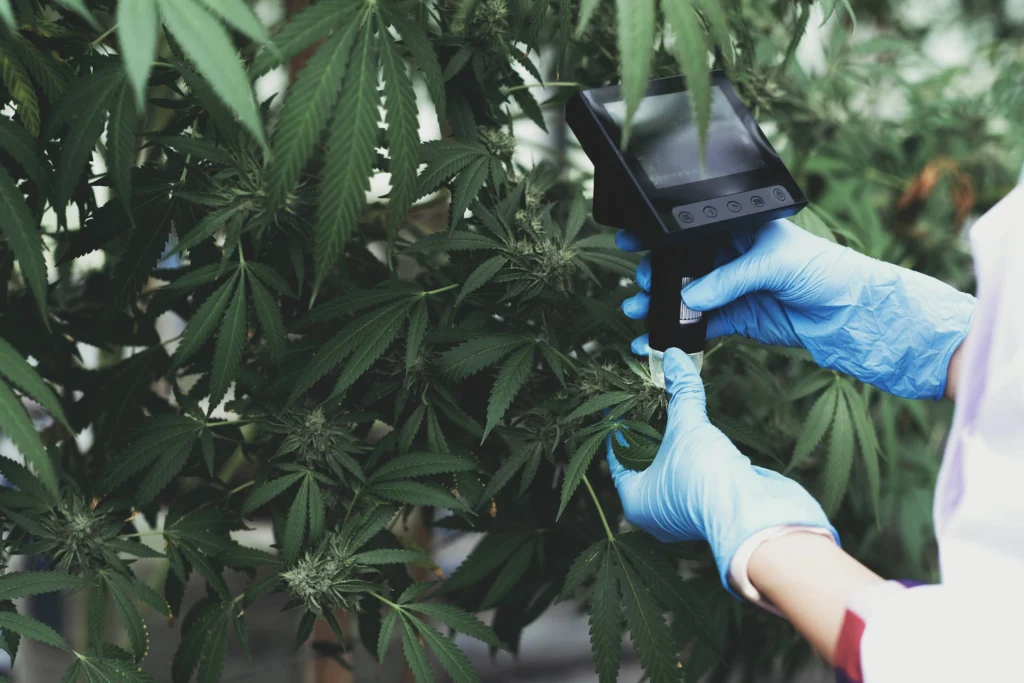Cannabis data analytics tools transform raw sales data into actionable insights that drive revenue growth, optimize inventory, and improve compliance. The US cannabis market reached $45 billion in 2025, and dispensaries using real-time analytics consistently outperform competitors lacking data visibility.
Modern cannabis analytics platforms integrate with POS systems, track consumer behavior patterns, and provide market intelligence across thousands of dispensaries. Choosing the right tool determines whether your business reacts to trends or predicts them.
Cannabis data analytics tools are specialized software platforms that collect, process, and visualize sales data, inventory metrics, customer behavior, and market trends specific to marijuana retail operations. These systems connect directly to dispensary POS systems and state tracking databases.
Cannabis data analytics tools in 2025 track sales performance, inventory turnover, compliance reporting, and consumer purchasing patterns through real-time dashboards. They help dispensaries optimize pricing, predict demand, and identify revenue opportunities by analyzing transaction data from thousands of retail locations.
The cannabis software industry encompasses POS providers, compliance platforms, market intelligence firms, and analytics specialists. Industry leaders include Headset with 3,500+ retail partners, BDSA covering 90% of market menus, and integrated solutions like WebJoint combining POS and analytics.
Unlike generic retail software, marijuana software companies must navigate state-specific regulations, seed-to-sale tracking requirements, and banking restrictions. This specialization creates platforms built specifically for cannabis compliance while delivering powerful business intelligence tools.
Expert Tip: Cannabis businesses generate more first-party transaction data than most retail sectors due to mandatory track-and-trace systems. Smart dispensaries leverage this regulatory requirement as a competitive advantage by choosing analytics platforms that transform compliance data into growth insights.
The marijuana industry database ecosystem includes retail sales tracking, consumer research panels, and market forecasting models. New Frontier Data analyzes 14,000 dispensary locations with 22 million verified device interactions, providing unprecedented visibility into shopper behavior and foot traffic patterns.
BDSA launched daily Menu Analytics in January 2024, enabling brands to monitor pricing, product availability, and competitor performance across regional markets. This real-time intelligence helps companies reduce out-of-stock losses and optimize distribution strategies with data-backed sales stories.
Case Example: Fernway, a cannabis brand, partnered with BDSA to track when specific SKUs stock out at retail customers. Their sales team uses daily alerts to prepare restock orders immediately, moving toward vendor-managed inventory efficiency and preventing revenue loss from empty shelves.

The legal cannabis industry added 440,445 full-time jobs in 2024, reflecting 5.4% growth from the previous year. As markets mature and competition intensifies, data-driven decision-making separates thriving dispensaries from those struggling with margin compression and inventory inefficiencies.
Analytics drive growth and compliance by revealing which products move fastest, which customer segments spend most, and when demand peaks occur. Dispensaries using real-time data optimize staffing, prevent stockouts, personalize promotions, and maintain audit-ready compliance records automatically.
Leading cannabis analytics solutions integrate three core capabilities: operational intelligence from POS data, market benchmarking against competitor performance, and predictive analytics forecasting future trends. Headset sources data from actual consumer transactions to deliver actionable insights on category performance and pricing strategies.
Happy Cabbage Analytics serves 400+ marijuana stores with AI-powered revenue optimization priced at $900 monthly. The platform helps retailers train budtenders, predict product demand, target consumers, and prioritize discount strategies that maximize sell-through rates.
Analytics Platform Comparison Checklist:
WebJoint combines dispensary POS functionality with built-in reporting and analytics, eliminating the need for third-party integrations. The platform automatically syncs compliance data while providing sales dashboards, inventory alerts, and customer behavior insights from a unified interface.
Headset processes a significant percentage of every dollar spent on cannabis in the US and Canada through its retail partner network. The platform aggregates point-of-sale data to identify best-selling products, busy shopping times, customer demographics, and pricing optimization opportunities.
Dispensaries using Headset’s business intelligence tools can benchmark their performance against market averages, track brand velocity, and measure promotion effectiveness. The data reveals seasonal trends, helps forecast demand spikes, and enables collaboration between retailers and supplier partners around shared metrics.
Performance Insight: Cannabis retailers leveraging market intelligence platforms report improved inventory efficiency by stocking products aligned with local consumer preferences rather than guessing based on anecdotal feedback. Data-driven assortment planning reduces capital tied up in slow-moving inventory.
Cannabis data platforms vary significantly in focus, from retail-specific operational tools to broad market intelligence services. BDSA and Headset lead market tracking across multiple states, while integrated POS solutions like WebJoint provide dispensary-level analytics without additional software costs.
Top platforms in 2025 include Headset for market intelligence across 3,500+ retailers, BDSA for daily menu analytics covering 90% of markets, New Frontier Data for foot traffic insights across 14,000 locations, and WebJoint for all-in-one POS with built-in analytics and compliance.
Leafly operates primarily as a consumer discovery platform connecting shoppers with dispensaries, offering menu management and some basic traffic analytics. Their strength lies in customer acquisition through brand awareness and SEO-driven traffic rather than deep operational intelligence.
WebJoint provides comprehensive operational analytics integrated directly into the POS system. Dispensaries track transaction history, inventory movement, delivery performance, customer retention rates, and compliance metrics without purchasing separate analytics software. The platform syncs automatically with METRC and BioTrack for real-time regulatory reporting.
Integration Advantage: All-in-one platforms like WebJoint eliminate data silos between POS transactions, e-commerce orders, and delivery operations. Unified dashboards show complete customer journeys and actual profitability across all sales channels rather than fragmented reports requiring manual consolidation.
BDSA specializes in retail sales tracking and market forecasting, helping brands and retailers understand category performance, pricing dynamics, and competitive positioning. Their Menu Analytics solution monitors product availability and markup strategies daily across participating dispensaries.
New Frontier Data focuses on consumer intelligence, foot traffic analysis, and marketing attribution. The platform tracks visitor patterns to measure store performance, understand shopper demographics, and calculate marketing ROI by connecting ad spend to actual store visits.
Market Research Application: Cannabis brands use BDSA data to identify underserved markets for expansion, optimize product development based on consumer demand patterns, and build sales presentations showing category growth rates and competitive market share to secure retailer shelf space.
Dispensary performance metrics fall into four categories: sales efficiency, inventory optimization, customer retention, and compliance adherence. Tracking the right KPIs reveals operational weaknesses and growth opportunities before they significantly impact profitability.
Essential dispensary metrics include sell-through rate showing inventory turnover speed, customer lifetime value measuring long-term revenue per shopper, average order value tracking transaction size, and retention rate revealing repeat purchase patterns. Combined, these metrics guide pricing, staffing, and marketing decisions.
Operational KPIs Every Cannabis Retailer Should Monitor:
AI-powered platforms like Pluggi analyze cannabis product recommendations by asking shoppers three questions about desired effects, then cross-referencing terpene profiles and strain data. Over 80 retailers use the chatbot, which integrates directly with e-commerce menus to personalize shopping experiences.
Expert Tip: Track metrics by time of day and day of week to identify peak traffic periods. Cannabis sales typically spike on Fridays (nearly 20% of weekly revenue) and Thursdays (15.24%). Optimize staffing and inventory availability around these high-volume windows.
Effective cannabis analytics platforms transform raw data into visual dashboards with charts, heat maps, and trend graphs. Mobile-accessible reports enable managers to monitor performance remotely and make real-time adjustments to staffing, pricing, or inventory allocation.
WebJoint’s reporting suite provides automated compliance exports for state regulators alongside business intelligence showing sales trends, product velocity, and customer segmentation. Every transaction and inventory movement syncs automatically, eliminating manual data entry and ensuring audit-ready documentation.
Visualization Case Study: A Colorado dispensary implemented dashboard analytics revealing that concentrate sales peaked during evening hours while flower dominated morning transactions. They adjusted budtender specialization by shift, increased concentrate inventory before 4 PM, and boosted category revenue 23% within three months.

The cannabis analytics market continues expanding as projected industry growth to $49.56 billion by 2029 drives demand for sophisticated business intelligence. Emerging AI integrations enable predictive inventory management, automated pricing optimization, and personalized customer recommendations at scale.
Selection factors include POS integration compatibility, compliance automation for your state’s tracking system, mobile dashboard access, scalability as you add locations, and pricing aligned with your revenue size. Prioritize platforms offering trial periods or demos before committing.
Cannabis analytics pricing varies dramatically based on feature depth and market coverage. Happy Cabbage charges $900 monthly for AI-powered revenue optimization, Jointly’s Spark Pro costs $499 per location monthly, while integrated POS solutions like WebJoint include analytics within base platform pricing.
Integration requirements determine implementation complexity and ongoing maintenance costs. Standalone analytics tools require API connections to your POS, compliance software, and e-commerce platform. All-in-one systems eliminate integration headaches by processing analytics natively within the operational software.
Buying Decision Framework:
Platform Compatibility Check: Verify that analytics tools support your state’s tracking system (METRC, BioTrack, Leaf, etc.) and integrate with your existing POS brand. Incompatible systems create data gaps and compliance risks requiring expensive custom development.
Start with analytics capabilities built into your POS system before adding specialized tools. WebJoint provides comprehensive operational reporting, compliance automation, and customer insights without additional software purchases or complex integrations.
As your dispensary scales, layer market intelligence platforms for competitive benchmarking and consumer research. The combination of internal operational data plus external market trends creates complete visibility into business performance and expansion opportunities.
Implementation Roadmap: Cannabis businesses generate complete transaction records due to regulatory requirements, creating rich datasets ready for analysis. The challenge isn’t data availability, it’s choosing platforms that transform compliance paperwork into strategic insights driving revenue growth and operational efficiency.
What are the best cannabis analytics tools in 2025?
Leading platforms include Headset for market intelligence across 3,500+ retailers, BDSA for daily menu tracking covering 90% of markets, and WebJoint for integrated POS with built-in analytics. Happy Cabbage serves 400+ stores with AI optimization. Choose based on whether you need market research or operational reporting.
Which metrics matter most for dispensary growth?
Focus on sell-through rate showing inventory turnover, average order value revealing transaction size, customer lifetime value measuring long-term revenue, and retention rate tracking repeat purchases. Combined with category-level gross margins, these metrics guide pricing, inventory, and marketing decisions driving profitability.
How accurate is cannabis sales data tracking?
State-mandated track-and-trace systems ensure high accuracy for compliance reporting. Cannabis retailers capture more complete transaction data than most industries due to regulatory requirements. Leading analytics platforms process millions of verified transactions daily, providing reliable market intelligence and performance benchmarks.
Is WebJoint a cannabis data analytics tool?
Yes, WebJoint is an all-in-one dispensary POS platform with integrated analytics and reporting. The system tracks sales performance, inventory metrics, delivery operations, and customer behavior while automatically syncing compliance data to METRC and BioTrack. Built-in dashboards eliminate the need for separate analytics software purchases.
Cannabis data analytics tools transform mandatory compliance tracking into competitive intelligence driving revenue growth. The industry’s 440,445 jobs in 2024 and projected expansion to nearly 800,000 by 2029 creates increasing demand for data-driven operational excellence.
Start with integrated POS analytics providing operational essentials, then layer market intelligence as your business scales. The dispensaries winning in 2025 leverage real-time data to predict demand, optimize pricing, personalize marketing, and maintain effortless compliance.Book a WebJoint demo to experience data-backed cannabis business growth today.